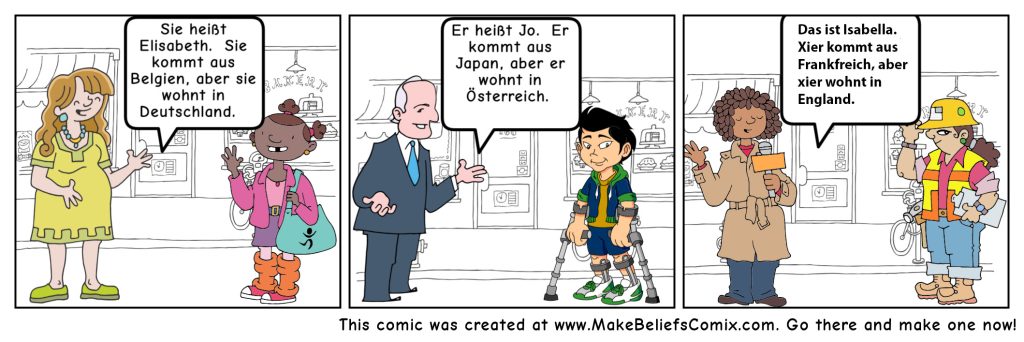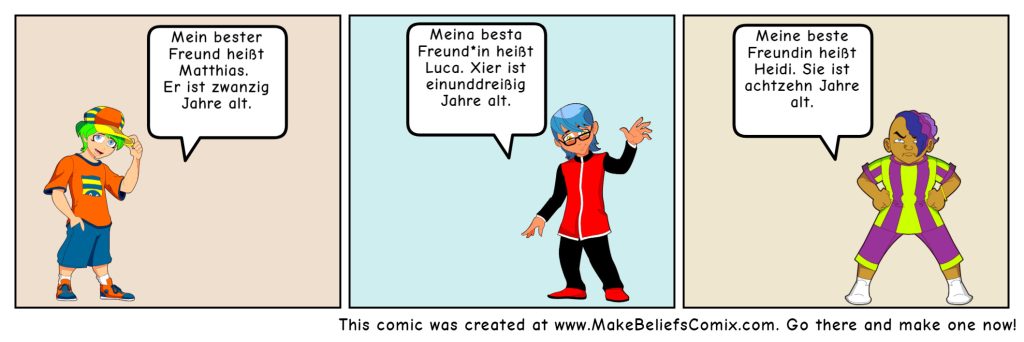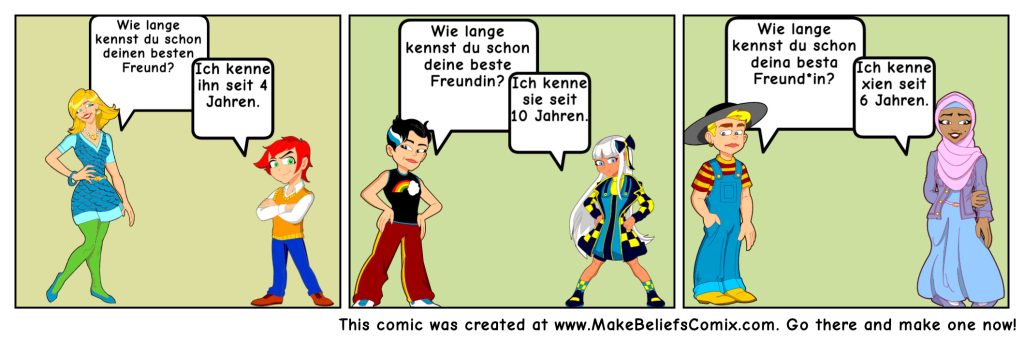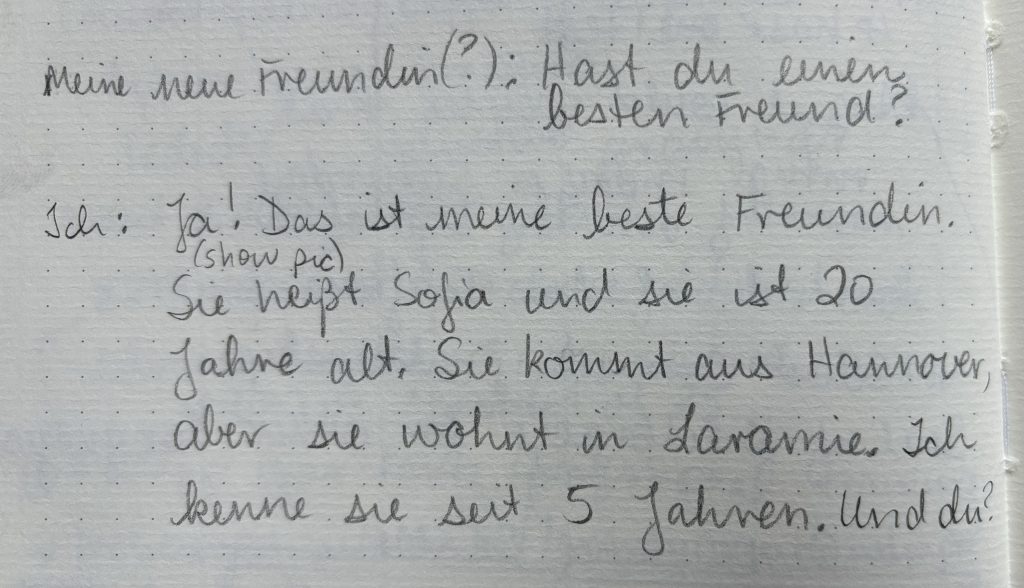4.1 Freundschaft

Hallo liebe Studierende!
Zum Aufwärmen machen wir unseren Tagesminiplausch und eine Wiederholung.
Wiederholung
In the previous lesson, you learned how to say what your favorite item of clothing is, what item of clothing you like, and what you like and do not like to wear. Let’s review what you have learned.
Welche Kleidung gefällt dir? Welche Kleidung gefällt dir nicht? Record your answers in your written journal naming at lease three items of clothing you like and three you do not like. Then read your sentences aloud in your audio journal.
Lektionsüberblick
Learning about someone’s friends can tell you a lot about that person. As you get to know people in Germany, you can talk about your friends back home. You have already learned enough German that you can now give a basic introduction and description of your friends. In this lesson, you will recall past lessons in service of describing your best friend. In the end, you will be able to 1) introduce your best friend, 2) state some of their basic biographical information, and 3) say how long you have known each other.
1) Introduce your best friend
Perhaps you have ein bester Freund, eine beste Freundin, or eina besta Freund*in.
Let’s see how these people introduce their best friends to you.
Let’s practice! Be sure to click through to each question/picture. If you want to challenge yourself, fill in the blanks without looking at the speech bubble!
Jetzt bist du dran!
2) Mehr zum besten Freund/ zur besten Freundin/ zur bestan Freund*in?
Let’s move to the next part of an introduction: Saying where someone is from, where they live, and how old they are. You may remember this from learning how to introduce yourself in Thema 1 and how to talk about your family and origins in Thema 2. If needed, you can review before moving on.
Now look at the cartoon below. Focus on how each person says where the other person lives and then where they come from. Then complete the activity.

Now let’s focus on stating the age of our best friend. If you need help with ages, review the numbers and listen for the age of your best friend.
Let’s practice stating our friend’s age. Read the comic and then listen, before completing the practice activities.
 |
||
Jetzt bist du dran!
Woher kommt er/sie/xier? Wo wohnt er/sie/xier? Wie alt ist er/sie/xier? Answer the questions in your written journal about your best friend, stating where they are from, where they live, and how old they are.
Frankfurt am Main im Blickpunkt

Frankfurt am Main ist eine moderne Stadt in Deutschland. Sie ist bekannt für ihre vielen hohen Gebäude und wird manchmal „Mainhattan“ genannt. Der Spitzname „Mainhattan“ ist ein Wortspiel: „Main“ kommt vom Fluss Main, an dem Frankfurt liegt. „Manhattan“ ist der berühmte Stadtteil von New York mit vielen Wolkenkratzern. 14 der 15 höchsten Wolkenkratzer Deutschlands stehen in Frankfurt.
Frankfurt am Main is a modern city in Germany. It is known for its many tall buildings and is sometimes called “Mainhattan.” The nickname “Mainhattan” is a play on words: “Main” comes from the River Main, on which Frankfurt is located. “Manhattan” is the famous New York City district with its many skyscrapers. 14 of the 15 highest skyscrapers in Germany are in Frankfurt.
3) Wie lange seid ihr befreundet? Wie lange kennt ihr euch?
You’ve learned how to use numbers to describe someone’s age. Let’s learn how to use numbers to describe a length of time.
 |
Ich habe viele Freunde, aber eine meiner besten Freundinnen ist Meike. Ich kenne Meike seit fünf Jahren. |
Now let’s practice! Read the comic and answer the questions.

🎥You can listen to a hit song by Nena called Du kennst die Liebe nicht (1985) that uses the word kennen that you just learned. Follow along with the lyrics and notice how many words you kennen!
Zum Schluß

When you are done, record yourself in your audio journal. If you can do it immediately without reading, that’s great! Otherwise, practice saying it a couple times before recording. Or rerecord, if you are not satisfied. Here is Julia’s recording:

*As you conclude this lesson, don’t forget to check Canvas!*

Media Attributions
- Friend descriptions adapted from Grenzenlos Deutsch, licensed under a CC BY-NC-SA 4.0 International License.
Media Attributions
- 1010-1020 banner long large reduced
- 4.1 comic file-66a13f7fc20c6 © This comic strip was generated at http://www.MakeBeliefsComix.com. Used by permission of author and site creator Bill Zimmerman.
- 4.1 comic age file-66a3baec486a7 © This comic strip was generated at http://www.MakeBeliefsComix.com. Used by permission of author and site creator Bill Zimmerman.
- Photo of Frankfurt am Main Skyline by Nicolas Scheuer, Wikipedia
- Image of Max from Grenzenlos Deutsch, GD Max.pgn_-211×300, licensed under a Creative Commons Attribution-NonCommercial-ShareAlike 4.0 International License. © Grenzenlos Deutsch is licensed under a CC BY-NC-SA (Attribution NonCommercial ShareAlike) license
- 4.1 3 kennen seit make-beliefs-comix © This comic strip was generated at http://www.MakeBeliefsComix.com. Used by permission of author and site creator Bill Zimmerman.
- 4.1 Julias jounal entry
- Private: confidence scale_large horizontal_updated

